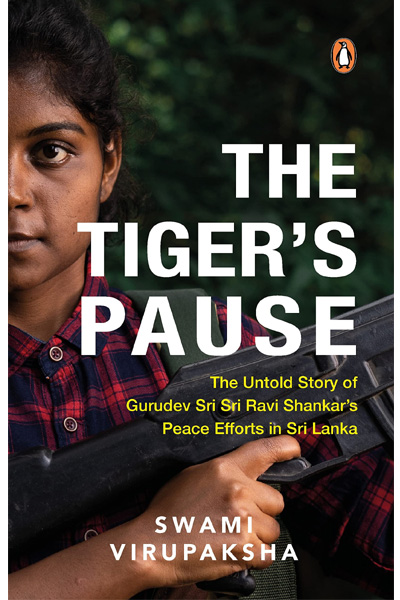in Sri Lanka to release on Feb 28
by Press Trust of India, February 2, 2022

New Delhi, Feb 2 (PTI) Revealing the untold story of Sri Sri Ravi Shankar’s peace efforts in Sri Lanka, a new book, “The Tiger’s Pause”, gives readers a sweeping view of the spiritual leader’s endeavours towards a ceasefire agreement in the island nation.
The book, scheduled to release on February 28, is published by Penguin Random House India (PRHI).
It is written by Swami Virupaksha, who as a key member of the spiritual leader’s conflict-resolution team spent nine years in Sri Lanka — during and after the country’s war-torn days.
The separatist group Liberation Tigers of Tamil Eelam (LTTE) waged a war with the Sri Lankan government to carve out a separate Tamil homeland with the conflict ending in 2009 when the government forces killed its chief Velupillai Prabhakaran.
“‘The Tiger’s Pause’ is a story of real leadership, the great lengths that Gurudev went to, risking his own life, doing all that it takes to restore peace and harmony. It is not just about his passion for helping others, but his care about solving problems that directly affect people’s lives, well – being and progress in a major way,” Virupaksha told PTI.

“In the years 2005-09, peace and prosperity for Sri Lanka was just a whisker away, when I saw, heard and felt ‘The Tiger’s Pause’,” he added.
As the fourth phase of the 26-year civil war in Sri Lanka was about to begin, Sri Sri Ravi Shankar, founder of the Art of Living, visited the island nation with a singular aim to bring peace to its citizens while trying to mediate between Prabhakaran, leader of the Liberation Tigers of Tamil Eelam (LTTE), and the government.
According to the publishers, in prose that is both concise and empathetic, Swami Virupaksha gives details of conspiracies, secrets, inside stories and massive revelations on the spiritual leader’s journey of peacemaking in Sri Lanka
“‘The Tiger’s Pause’ chronicles Gurudev’s time in a highly strung country and also offers an exclusive look into the final chapters of Sri Lanka’s deadly conflict. It is the narrative of the Sri Lankan people, and gives us a sense of what it takes to understand and address a shared trauma,” wrote the publishers in its description of the book. PTI MG RB
RB